Challenges in Educating Indian Migrants: Green Building Construction
VerifiedAdded on 2021/04/21
|24
|5832
|33
Report
AI Summary
This report delves into the challenges associated with educating Indian migrant workers in the green building construction industry. The research analyzes data collected from secondary sources, including academic journals and industry reports, to identify key obstacles. The core challenges discussed include communication barriers stemming from language and cultural differences, as well as differing work attitudes and practices. The report examines the impact of these factors on project management, training schedules, and overall project success. It provides a detailed evaluation of these challenges, offering insights into their origins and potential mitigation strategies. The analysis covers various aspects, such as communication difficulties, cultural variations, and differing work ethics. The findings highlight the need for tailored approaches to address the unique needs of Indian migrant workers in green construction projects. Finally, the report concludes by summarizing the findings and suggesting strategies to address the challenges identified, aiming to improve project outcomes and promote effective training for Indian migrants in the green building sector.
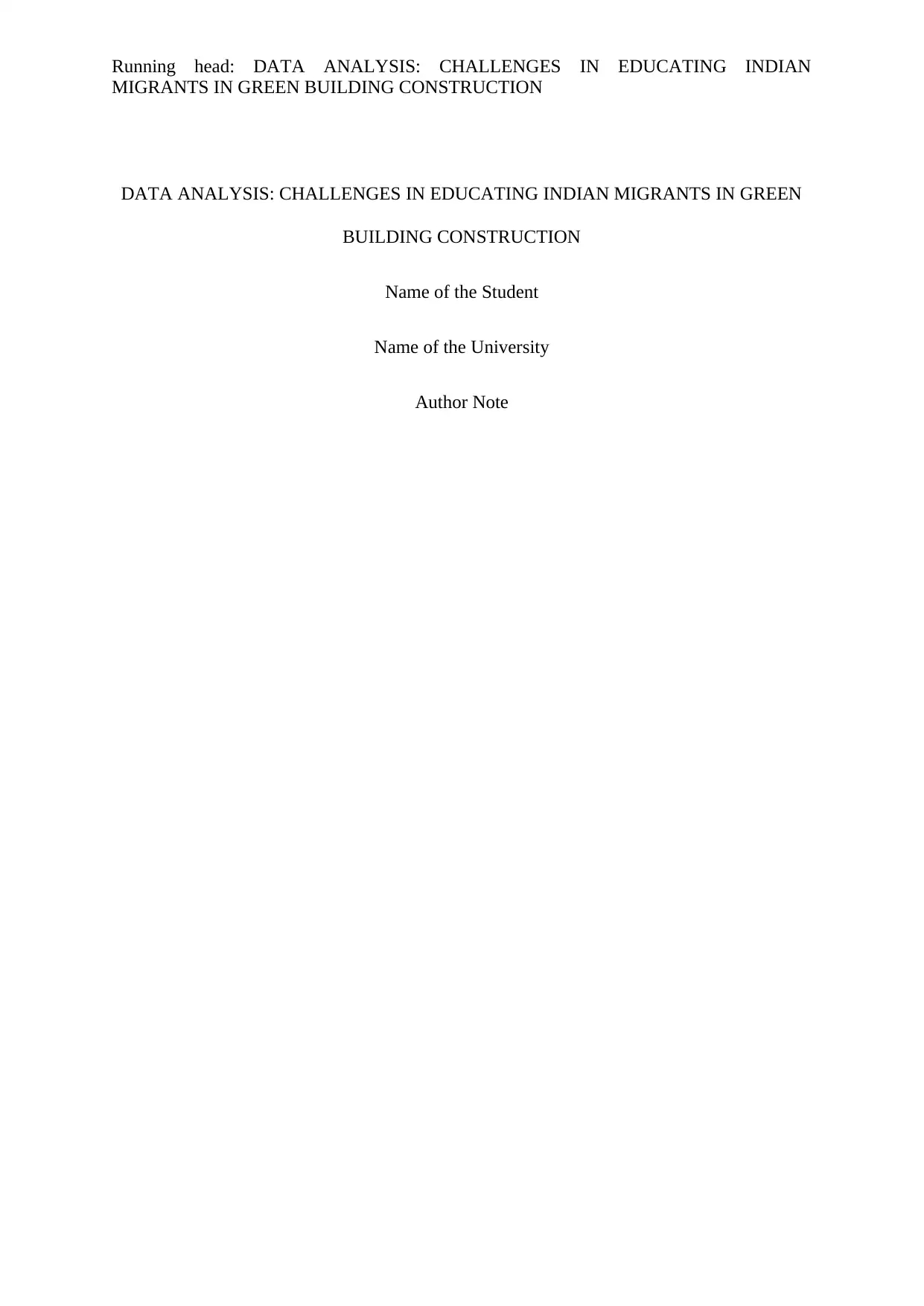
Running head: DATA ANALYSIS: CHALLENGES IN EDUCATING INDIAN
MIGRANTS IN GREEN BUILDING CONSTRUCTION
DATA ANALYSIS: CHALLENGES IN EDUCATING INDIAN MIGRANTS IN GREEN
BUILDING CONSTRUCTION
Name of the Student
Name of the University
Author Note
MIGRANTS IN GREEN BUILDING CONSTRUCTION
DATA ANALYSIS: CHALLENGES IN EDUCATING INDIAN MIGRANTS IN GREEN
BUILDING CONSTRUCTION
Name of the Student
Name of the University
Author Note
Paraphrase This Document
Need a fresh take? Get an instant paraphrase of this document with our AI Paraphraser
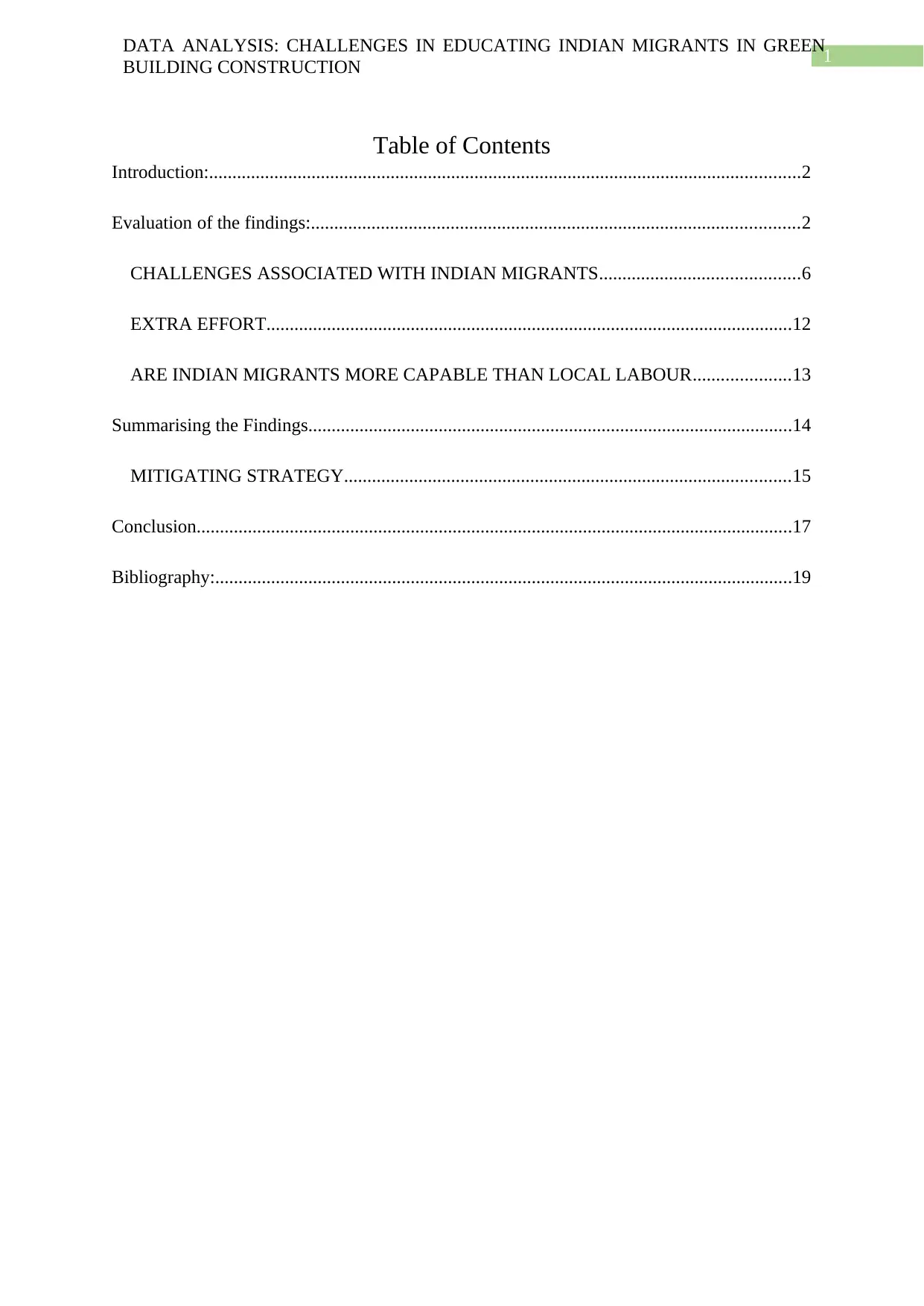
1
DATA ANALYSIS: CHALLENGES IN EDUCATING INDIAN MIGRANTS IN GREEN
BUILDING CONSTRUCTION
Table of Contents
Introduction:...............................................................................................................................2
Evaluation of the findings:.........................................................................................................2
CHALLENGES ASSOCIATED WITH INDIAN MIGRANTS...........................................6
EXTRA EFFORT.................................................................................................................12
ARE INDIAN MIGRANTS MORE CAPABLE THAN LOCAL LABOUR.....................13
Summarising the Findings........................................................................................................14
MITIGATING STRATEGY................................................................................................15
Conclusion................................................................................................................................17
Bibliography:............................................................................................................................19
DATA ANALYSIS: CHALLENGES IN EDUCATING INDIAN MIGRANTS IN GREEN
BUILDING CONSTRUCTION
Table of Contents
Introduction:...............................................................................................................................2
Evaluation of the findings:.........................................................................................................2
CHALLENGES ASSOCIATED WITH INDIAN MIGRANTS...........................................6
EXTRA EFFORT.................................................................................................................12
ARE INDIAN MIGRANTS MORE CAPABLE THAN LOCAL LABOUR.....................13
Summarising the Findings........................................................................................................14
MITIGATING STRATEGY................................................................................................15
Conclusion................................................................................................................................17
Bibliography:............................................................................................................................19
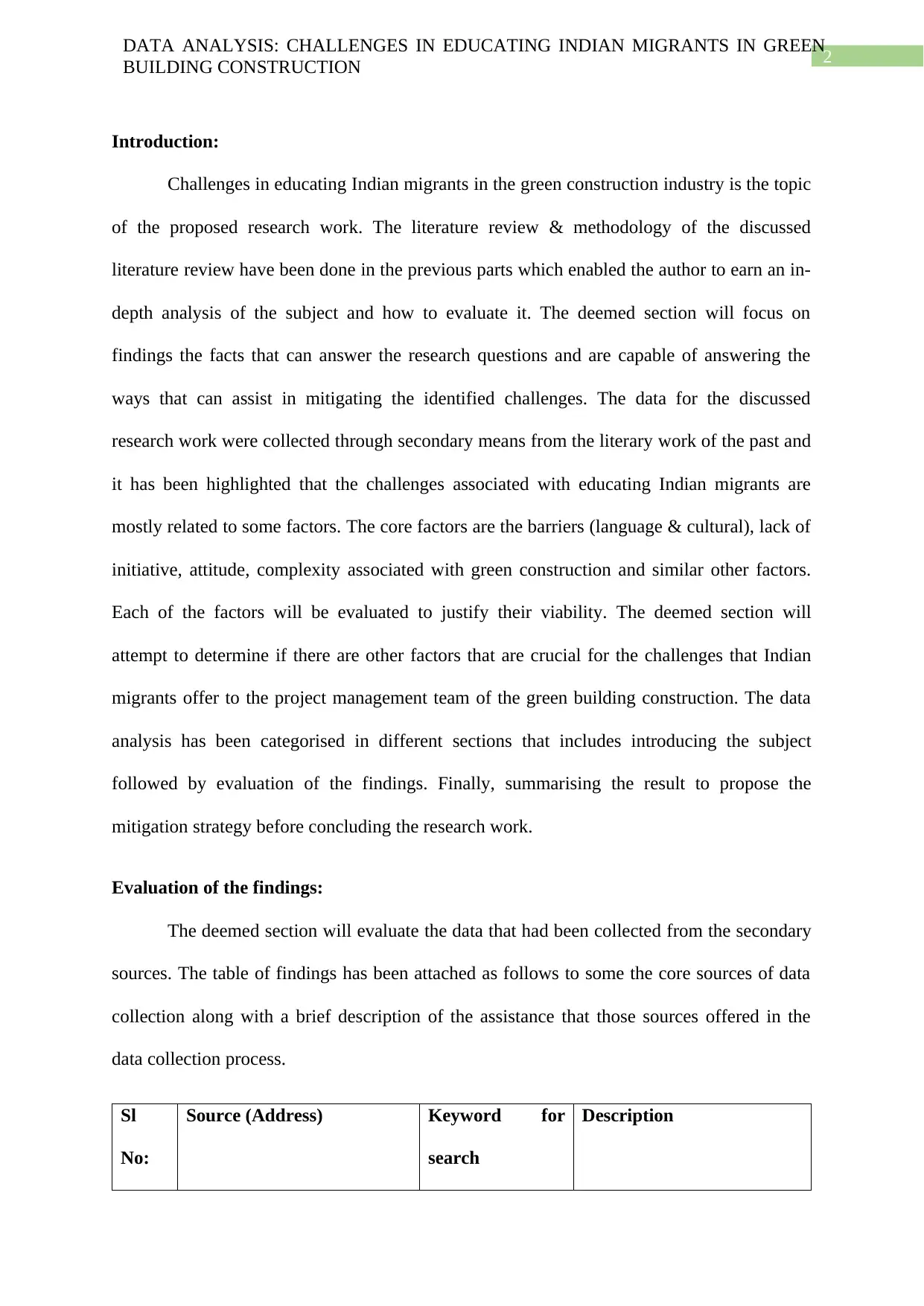
2
DATA ANALYSIS: CHALLENGES IN EDUCATING INDIAN MIGRANTS IN GREEN
BUILDING CONSTRUCTION
Introduction:
Challenges in educating Indian migrants in the green construction industry is the topic
of the proposed research work. The literature review & methodology of the discussed
literature review have been done in the previous parts which enabled the author to earn an in-
depth analysis of the subject and how to evaluate it. The deemed section will focus on
findings the facts that can answer the research questions and are capable of answering the
ways that can assist in mitigating the identified challenges. The data for the discussed
research work were collected through secondary means from the literary work of the past and
it has been highlighted that the challenges associated with educating Indian migrants are
mostly related to some factors. The core factors are the barriers (language & cultural), lack of
initiative, attitude, complexity associated with green construction and similar other factors.
Each of the factors will be evaluated to justify their viability. The deemed section will
attempt to determine if there are other factors that are crucial for the challenges that Indian
migrants offer to the project management team of the green building construction. The data
analysis has been categorised in different sections that includes introducing the subject
followed by evaluation of the findings. Finally, summarising the result to propose the
mitigation strategy before concluding the research work.
Evaluation of the findings:
The deemed section will evaluate the data that had been collected from the secondary
sources. The table of findings has been attached as follows to some the core sources of data
collection along with a brief description of the assistance that those sources offered in the
data collection process.
Sl
No:
Source (Address) Keyword for
search
Description
DATA ANALYSIS: CHALLENGES IN EDUCATING INDIAN MIGRANTS IN GREEN
BUILDING CONSTRUCTION
Introduction:
Challenges in educating Indian migrants in the green construction industry is the topic
of the proposed research work. The literature review & methodology of the discussed
literature review have been done in the previous parts which enabled the author to earn an in-
depth analysis of the subject and how to evaluate it. The deemed section will focus on
findings the facts that can answer the research questions and are capable of answering the
ways that can assist in mitigating the identified challenges. The data for the discussed
research work were collected through secondary means from the literary work of the past and
it has been highlighted that the challenges associated with educating Indian migrants are
mostly related to some factors. The core factors are the barriers (language & cultural), lack of
initiative, attitude, complexity associated with green construction and similar other factors.
Each of the factors will be evaluated to justify their viability. The deemed section will
attempt to determine if there are other factors that are crucial for the challenges that Indian
migrants offer to the project management team of the green building construction. The data
analysis has been categorised in different sections that includes introducing the subject
followed by evaluation of the findings. Finally, summarising the result to propose the
mitigation strategy before concluding the research work.
Evaluation of the findings:
The deemed section will evaluate the data that had been collected from the secondary
sources. The table of findings has been attached as follows to some the core sources of data
collection along with a brief description of the assistance that those sources offered in the
data collection process.
Sl
No:
Source (Address) Keyword for
search
Description
⊘ This is a preview!⊘
Do you want full access?
Subscribe today to unlock all pages.

Trusted by 1+ million students worldwide
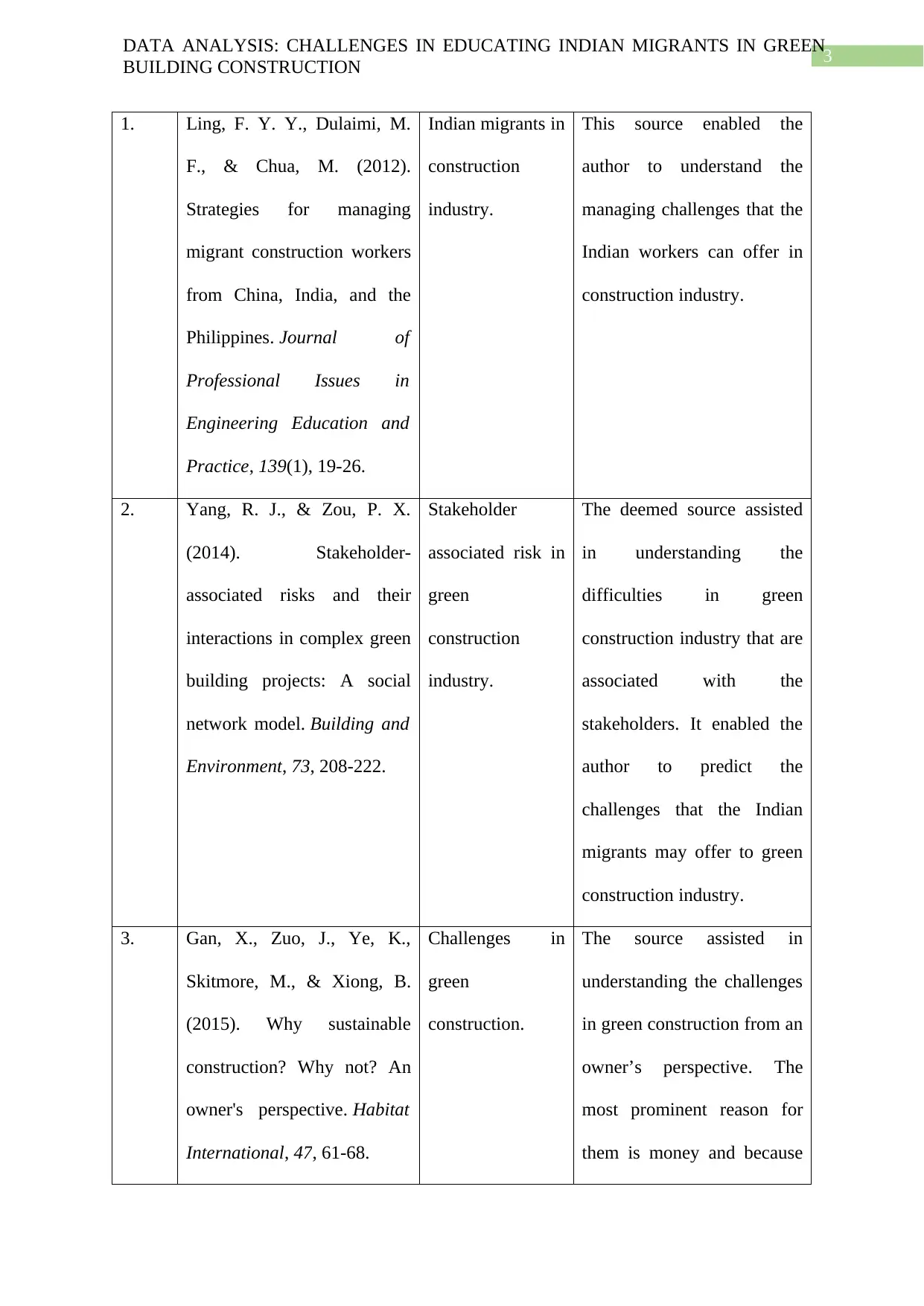
3
DATA ANALYSIS: CHALLENGES IN EDUCATING INDIAN MIGRANTS IN GREEN
BUILDING CONSTRUCTION
1. Ling, F. Y. Y., Dulaimi, M.
F., & Chua, M. (2012).
Strategies for managing
migrant construction workers
from China, India, and the
Philippines. Journal of
Professional Issues in
Engineering Education and
Practice, 139(1), 19-26.
Indian migrants in
construction
industry.
This source enabled the
author to understand the
managing challenges that the
Indian workers can offer in
construction industry.
2. Yang, R. J., & Zou, P. X.
(2014). Stakeholder-
associated risks and their
interactions in complex green
building projects: A social
network model. Building and
Environment, 73, 208-222.
Stakeholder
associated risk in
green
construction
industry.
The deemed source assisted
in understanding the
difficulties in green
construction industry that are
associated with the
stakeholders. It enabled the
author to predict the
challenges that the Indian
migrants may offer to green
construction industry.
3. Gan, X., Zuo, J., Ye, K.,
Skitmore, M., & Xiong, B.
(2015). Why sustainable
construction? Why not? An
owner's perspective. Habitat
International, 47, 61-68.
Challenges in
green
construction.
The source assisted in
understanding the challenges
in green construction from an
owner’s perspective. The
most prominent reason for
them is money and because
DATA ANALYSIS: CHALLENGES IN EDUCATING INDIAN MIGRANTS IN GREEN
BUILDING CONSTRUCTION
1. Ling, F. Y. Y., Dulaimi, M.
F., & Chua, M. (2012).
Strategies for managing
migrant construction workers
from China, India, and the
Philippines. Journal of
Professional Issues in
Engineering Education and
Practice, 139(1), 19-26.
Indian migrants in
construction
industry.
This source enabled the
author to understand the
managing challenges that the
Indian workers can offer in
construction industry.
2. Yang, R. J., & Zou, P. X.
(2014). Stakeholder-
associated risks and their
interactions in complex green
building projects: A social
network model. Building and
Environment, 73, 208-222.
Stakeholder
associated risk in
green
construction
industry.
The deemed source assisted
in understanding the
difficulties in green
construction industry that are
associated with the
stakeholders. It enabled the
author to predict the
challenges that the Indian
migrants may offer to green
construction industry.
3. Gan, X., Zuo, J., Ye, K.,
Skitmore, M., & Xiong, B.
(2015). Why sustainable
construction? Why not? An
owner's perspective. Habitat
International, 47, 61-68.
Challenges in
green
construction.
The source assisted in
understanding the challenges
in green construction from an
owner’s perspective. The
most prominent reason for
them is money and because
Paraphrase This Document
Need a fresh take? Get an instant paraphrase of this document with our AI Paraphraser
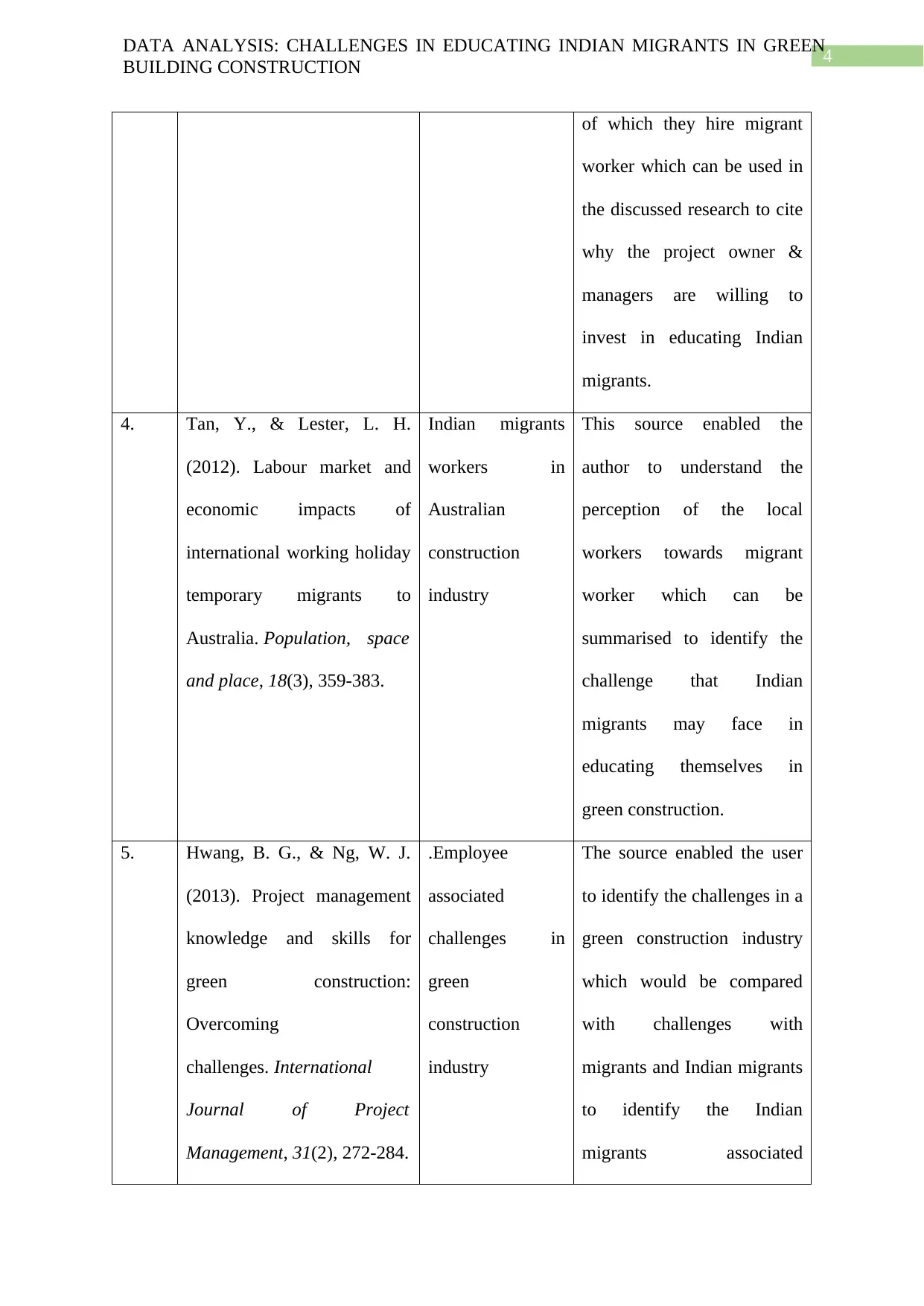
4
DATA ANALYSIS: CHALLENGES IN EDUCATING INDIAN MIGRANTS IN GREEN
BUILDING CONSTRUCTION
of which they hire migrant
worker which can be used in
the discussed research to cite
why the project owner &
managers are willing to
invest in educating Indian
migrants.
4. Tan, Y., & Lester, L. H.
(2012). Labour market and
economic impacts of
international working holiday
temporary migrants to
Australia. Population, space
and place, 18(3), 359-383.
Indian migrants
workers in
Australian
construction
industry
This source enabled the
author to understand the
perception of the local
workers towards migrant
worker which can be
summarised to identify the
challenge that Indian
migrants may face in
educating themselves in
green construction.
5. Hwang, B. G., & Ng, W. J.
(2013). Project management
knowledge and skills for
green construction:
Overcoming
challenges. International
Journal of Project
Management, 31(2), 272-284.
.Employee
associated
challenges in
green
construction
industry
The source enabled the user
to identify the challenges in a
green construction industry
which would be compared
with challenges with
migrants and Indian migrants
to identify the Indian
migrants associated
DATA ANALYSIS: CHALLENGES IN EDUCATING INDIAN MIGRANTS IN GREEN
BUILDING CONSTRUCTION
of which they hire migrant
worker which can be used in
the discussed research to cite
why the project owner &
managers are willing to
invest in educating Indian
migrants.
4. Tan, Y., & Lester, L. H.
(2012). Labour market and
economic impacts of
international working holiday
temporary migrants to
Australia. Population, space
and place, 18(3), 359-383.
Indian migrants
workers in
Australian
construction
industry
This source enabled the
author to understand the
perception of the local
workers towards migrant
worker which can be
summarised to identify the
challenge that Indian
migrants may face in
educating themselves in
green construction.
5. Hwang, B. G., & Ng, W. J.
(2013). Project management
knowledge and skills for
green construction:
Overcoming
challenges. International
Journal of Project
Management, 31(2), 272-284.
.Employee
associated
challenges in
green
construction
industry
The source enabled the user
to identify the challenges in a
green construction industry
which would be compared
with challenges with
migrants and Indian migrants
to identify the Indian
migrants associated
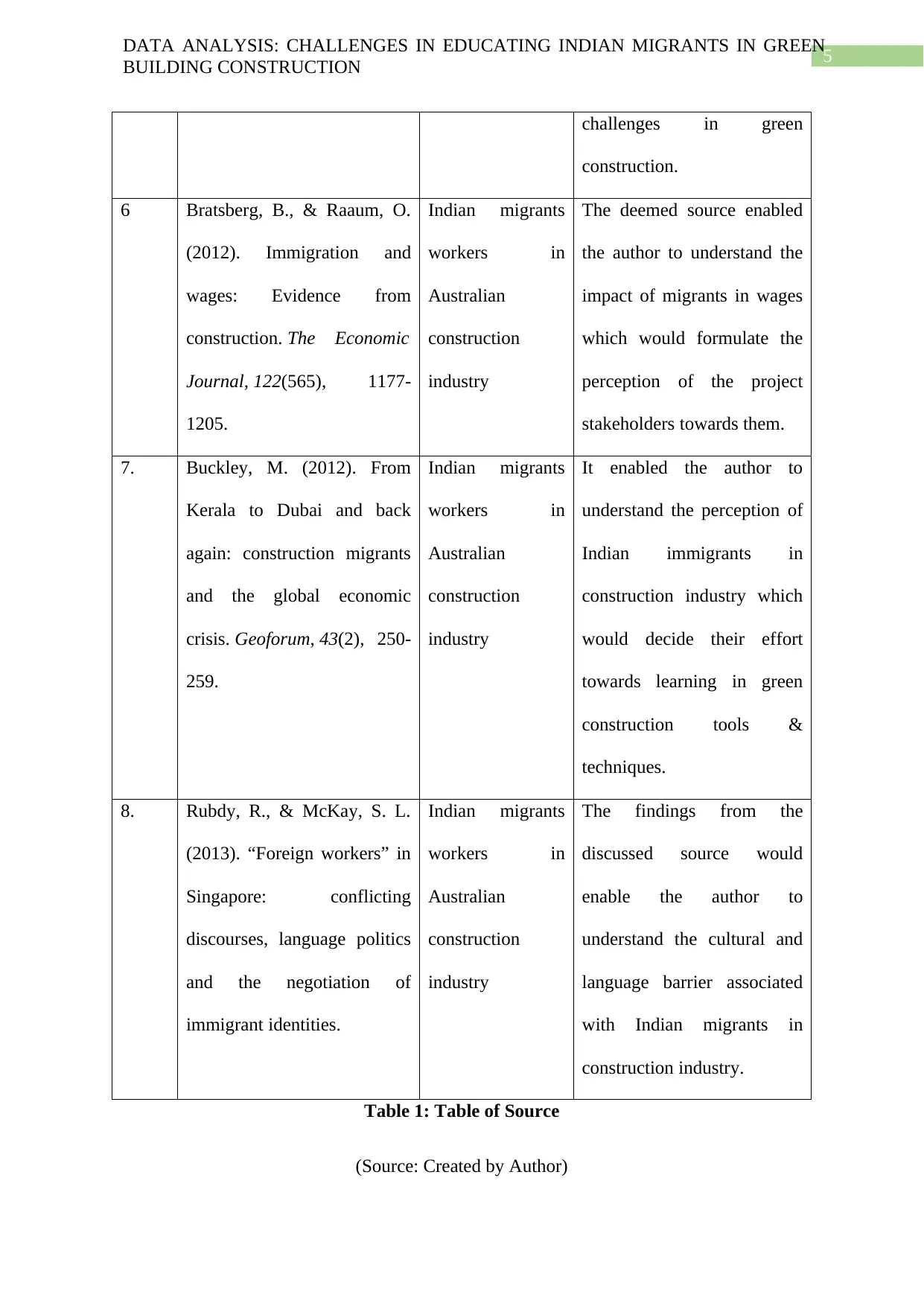
5
DATA ANALYSIS: CHALLENGES IN EDUCATING INDIAN MIGRANTS IN GREEN
BUILDING CONSTRUCTION
challenges in green
construction.
6 Bratsberg, B., & Raaum, O.
(2012). Immigration and
wages: Evidence from
construction. The Economic
Journal, 122(565), 1177-
1205.
Indian migrants
workers in
Australian
construction
industry
The deemed source enabled
the author to understand the
impact of migrants in wages
which would formulate the
perception of the project
stakeholders towards them.
7. Buckley, M. (2012). From
Kerala to Dubai and back
again: construction migrants
and the global economic
crisis. Geoforum, 43(2), 250-
259.
Indian migrants
workers in
Australian
construction
industry
It enabled the author to
understand the perception of
Indian immigrants in
construction industry which
would decide their effort
towards learning in green
construction tools &
techniques.
8. Rubdy, R., & McKay, S. L.
(2013). “Foreign workers” in
Singapore: conflicting
discourses, language politics
and the negotiation of
immigrant identities.
Indian migrants
workers in
Australian
construction
industry
The findings from the
discussed source would
enable the author to
understand the cultural and
language barrier associated
with Indian migrants in
construction industry.
Table 1: Table of Source
(Source: Created by Author)
DATA ANALYSIS: CHALLENGES IN EDUCATING INDIAN MIGRANTS IN GREEN
BUILDING CONSTRUCTION
challenges in green
construction.
6 Bratsberg, B., & Raaum, O.
(2012). Immigration and
wages: Evidence from
construction. The Economic
Journal, 122(565), 1177-
1205.
Indian migrants
workers in
Australian
construction
industry
The deemed source enabled
the author to understand the
impact of migrants in wages
which would formulate the
perception of the project
stakeholders towards them.
7. Buckley, M. (2012). From
Kerala to Dubai and back
again: construction migrants
and the global economic
crisis. Geoforum, 43(2), 250-
259.
Indian migrants
workers in
Australian
construction
industry
It enabled the author to
understand the perception of
Indian immigrants in
construction industry which
would decide their effort
towards learning in green
construction tools &
techniques.
8. Rubdy, R., & McKay, S. L.
(2013). “Foreign workers” in
Singapore: conflicting
discourses, language politics
and the negotiation of
immigrant identities.
Indian migrants
workers in
Australian
construction
industry
The findings from the
discussed source would
enable the author to
understand the cultural and
language barrier associated
with Indian migrants in
construction industry.
Table 1: Table of Source
(Source: Created by Author)
⊘ This is a preview!⊘
Do you want full access?
Subscribe today to unlock all pages.

Trusted by 1+ million students worldwide
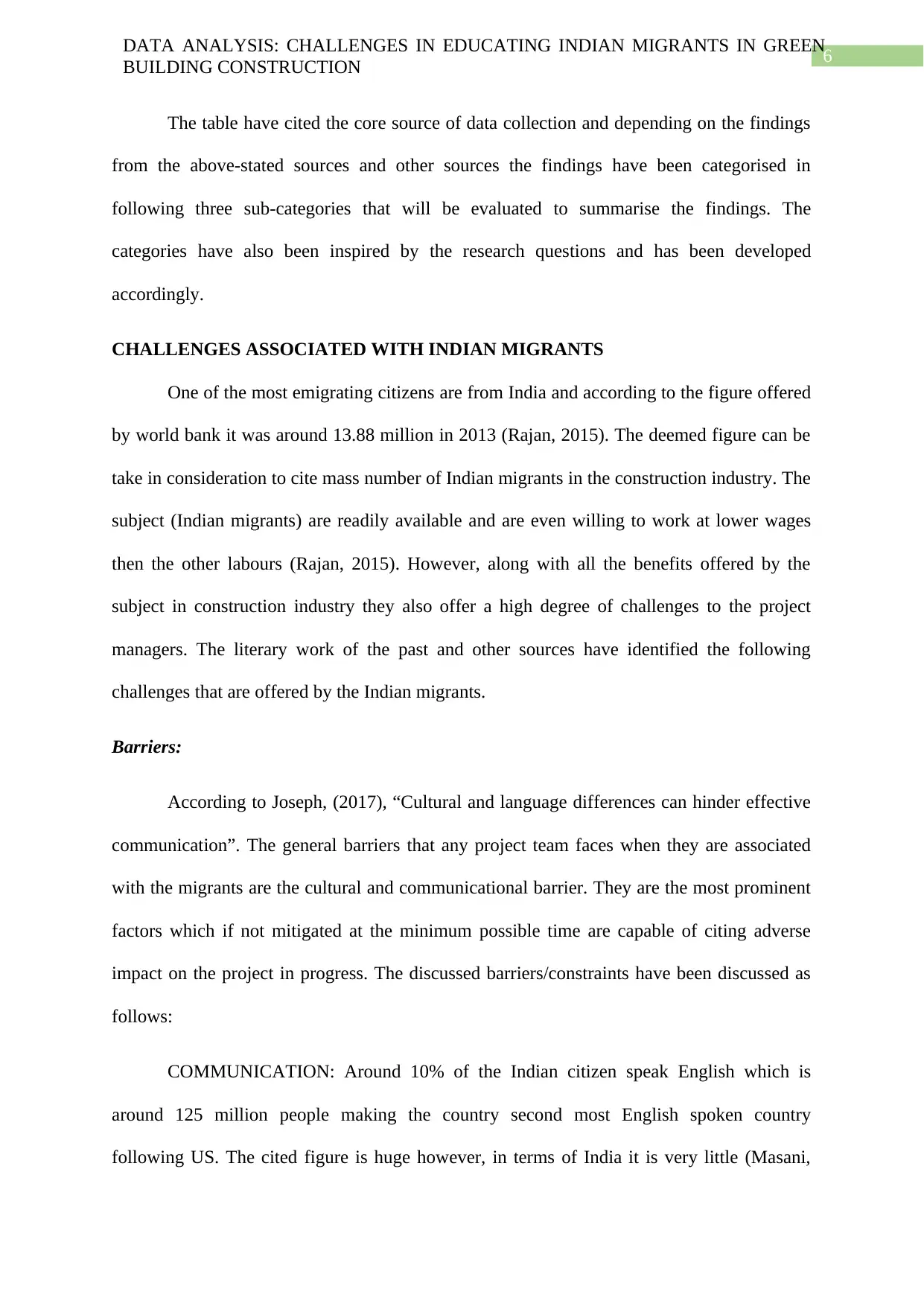
6
DATA ANALYSIS: CHALLENGES IN EDUCATING INDIAN MIGRANTS IN GREEN
BUILDING CONSTRUCTION
The table have cited the core source of data collection and depending on the findings
from the above-stated sources and other sources the findings have been categorised in
following three sub-categories that will be evaluated to summarise the findings. The
categories have also been inspired by the research questions and has been developed
accordingly.
CHALLENGES ASSOCIATED WITH INDIAN MIGRANTS
One of the most emigrating citizens are from India and according to the figure offered
by world bank it was around 13.88 million in 2013 (Rajan, 2015). The deemed figure can be
take in consideration to cite mass number of Indian migrants in the construction industry. The
subject (Indian migrants) are readily available and are even willing to work at lower wages
then the other labours (Rajan, 2015). However, along with all the benefits offered by the
subject in construction industry they also offer a high degree of challenges to the project
managers. The literary work of the past and other sources have identified the following
challenges that are offered by the Indian migrants.
Barriers:
According to Joseph, (2017), “Cultural and language differences can hinder effective
communication”. The general barriers that any project team faces when they are associated
with the migrants are the cultural and communicational barrier. They are the most prominent
factors which if not mitigated at the minimum possible time are capable of citing adverse
impact on the project in progress. The discussed barriers/constraints have been discussed as
follows:
COMMUNICATION: Around 10% of the Indian citizen speak English which is
around 125 million people making the country second most English spoken country
following US. The cited figure is huge however, in terms of India it is very little (Masani,
DATA ANALYSIS: CHALLENGES IN EDUCATING INDIAN MIGRANTS IN GREEN
BUILDING CONSTRUCTION
The table have cited the core source of data collection and depending on the findings
from the above-stated sources and other sources the findings have been categorised in
following three sub-categories that will be evaluated to summarise the findings. The
categories have also been inspired by the research questions and has been developed
accordingly.
CHALLENGES ASSOCIATED WITH INDIAN MIGRANTS
One of the most emigrating citizens are from India and according to the figure offered
by world bank it was around 13.88 million in 2013 (Rajan, 2015). The deemed figure can be
take in consideration to cite mass number of Indian migrants in the construction industry. The
subject (Indian migrants) are readily available and are even willing to work at lower wages
then the other labours (Rajan, 2015). However, along with all the benefits offered by the
subject in construction industry they also offer a high degree of challenges to the project
managers. The literary work of the past and other sources have identified the following
challenges that are offered by the Indian migrants.
Barriers:
According to Joseph, (2017), “Cultural and language differences can hinder effective
communication”. The general barriers that any project team faces when they are associated
with the migrants are the cultural and communicational barrier. They are the most prominent
factors which if not mitigated at the minimum possible time are capable of citing adverse
impact on the project in progress. The discussed barriers/constraints have been discussed as
follows:
COMMUNICATION: Around 10% of the Indian citizen speak English which is
around 125 million people making the country second most English spoken country
following US. The cited figure is huge however, in terms of India it is very little (Masani,
Paraphrase This Document
Need a fresh take? Get an instant paraphrase of this document with our AI Paraphraser
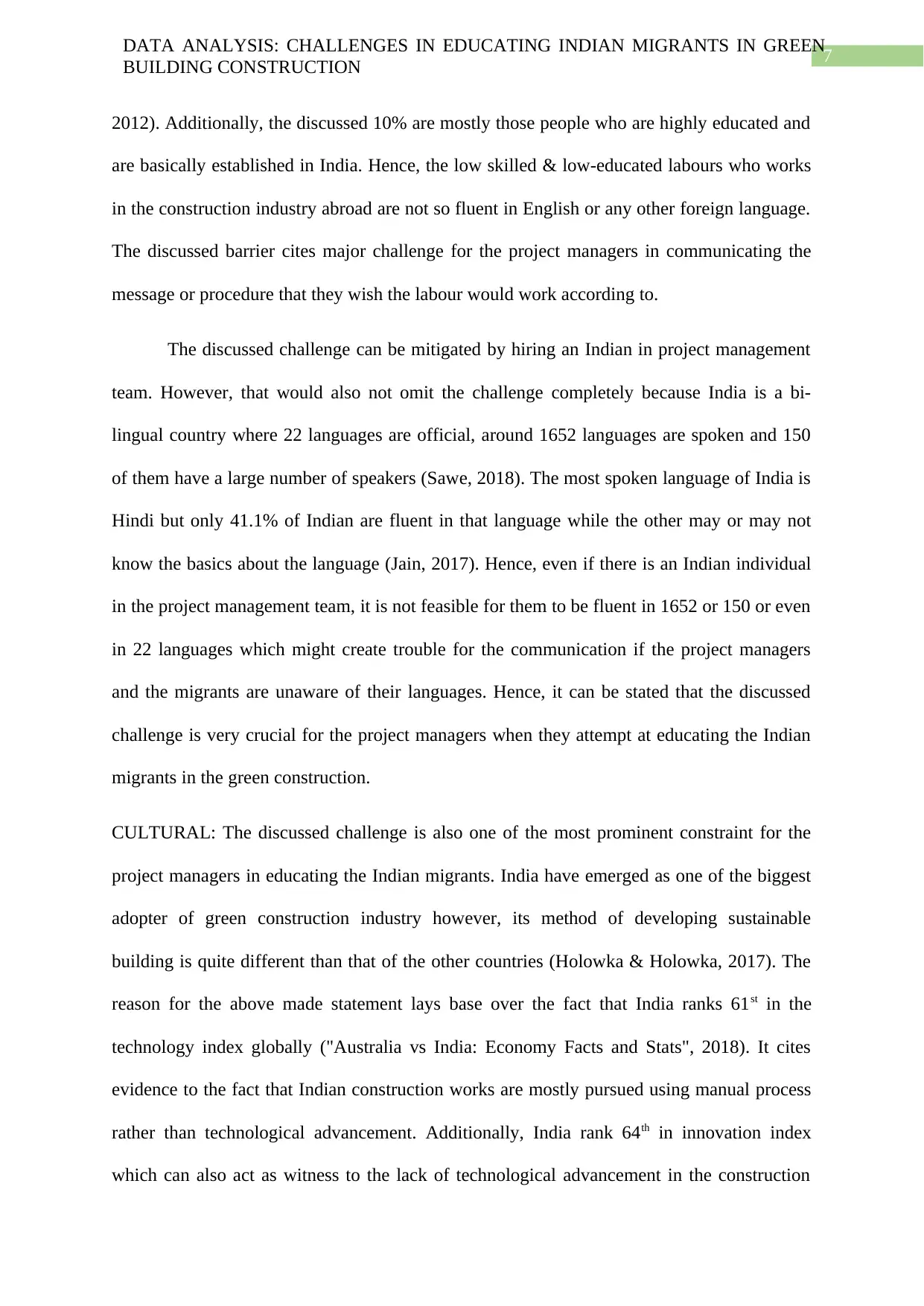
7
DATA ANALYSIS: CHALLENGES IN EDUCATING INDIAN MIGRANTS IN GREEN
BUILDING CONSTRUCTION
2012). Additionally, the discussed 10% are mostly those people who are highly educated and
are basically established in India. Hence, the low skilled & low-educated labours who works
in the construction industry abroad are not so fluent in English or any other foreign language.
The discussed barrier cites major challenge for the project managers in communicating the
message or procedure that they wish the labour would work according to.
The discussed challenge can be mitigated by hiring an Indian in project management
team. However, that would also not omit the challenge completely because India is a bi-
lingual country where 22 languages are official, around 1652 languages are spoken and 150
of them have a large number of speakers (Sawe, 2018). The most spoken language of India is
Hindi but only 41.1% of Indian are fluent in that language while the other may or may not
know the basics about the language (Jain, 2017). Hence, even if there is an Indian individual
in the project management team, it is not feasible for them to be fluent in 1652 or 150 or even
in 22 languages which might create trouble for the communication if the project managers
and the migrants are unaware of their languages. Hence, it can be stated that the discussed
challenge is very crucial for the project managers when they attempt at educating the Indian
migrants in the green construction.
CULTURAL: The discussed challenge is also one of the most prominent constraint for the
project managers in educating the Indian migrants. India have emerged as one of the biggest
adopter of green construction industry however, its method of developing sustainable
building is quite different than that of the other countries (Holowka & Holowka, 2017). The
reason for the above made statement lays base over the fact that India ranks 61st in the
technology index globally ("Australia vs India: Economy Facts and Stats", 2018). It cites
evidence to the fact that Indian construction works are mostly pursued using manual process
rather than technological advancement. Additionally, India rank 64th in innovation index
which can also act as witness to the lack of technological advancement in the construction
DATA ANALYSIS: CHALLENGES IN EDUCATING INDIAN MIGRANTS IN GREEN
BUILDING CONSTRUCTION
2012). Additionally, the discussed 10% are mostly those people who are highly educated and
are basically established in India. Hence, the low skilled & low-educated labours who works
in the construction industry abroad are not so fluent in English or any other foreign language.
The discussed barrier cites major challenge for the project managers in communicating the
message or procedure that they wish the labour would work according to.
The discussed challenge can be mitigated by hiring an Indian in project management
team. However, that would also not omit the challenge completely because India is a bi-
lingual country where 22 languages are official, around 1652 languages are spoken and 150
of them have a large number of speakers (Sawe, 2018). The most spoken language of India is
Hindi but only 41.1% of Indian are fluent in that language while the other may or may not
know the basics about the language (Jain, 2017). Hence, even if there is an Indian individual
in the project management team, it is not feasible for them to be fluent in 1652 or 150 or even
in 22 languages which might create trouble for the communication if the project managers
and the migrants are unaware of their languages. Hence, it can be stated that the discussed
challenge is very crucial for the project managers when they attempt at educating the Indian
migrants in the green construction.
CULTURAL: The discussed challenge is also one of the most prominent constraint for the
project managers in educating the Indian migrants. India have emerged as one of the biggest
adopter of green construction industry however, its method of developing sustainable
building is quite different than that of the other countries (Holowka & Holowka, 2017). The
reason for the above made statement lays base over the fact that India ranks 61st in the
technology index globally ("Australia vs India: Economy Facts and Stats", 2018). It cites
evidence to the fact that Indian construction works are mostly pursued using manual process
rather than technological advancement. Additionally, India rank 64th in innovation index
which can also act as witness to the lack of technological advancement in the construction
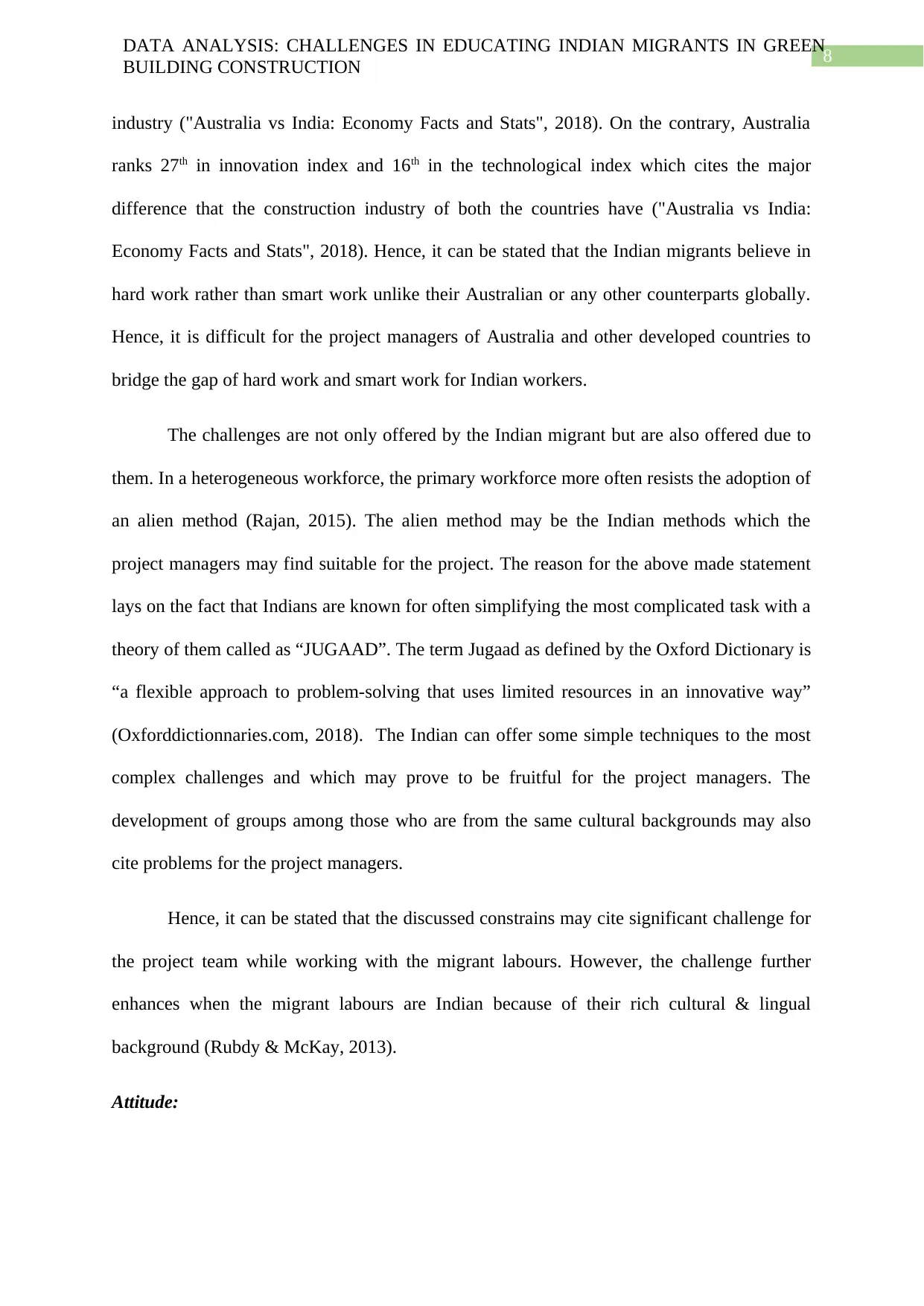
8
DATA ANALYSIS: CHALLENGES IN EDUCATING INDIAN MIGRANTS IN GREEN
BUILDING CONSTRUCTION
industry ("Australia vs India: Economy Facts and Stats", 2018). On the contrary, Australia
ranks 27th in innovation index and 16th in the technological index which cites the major
difference that the construction industry of both the countries have ("Australia vs India:
Economy Facts and Stats", 2018). Hence, it can be stated that the Indian migrants believe in
hard work rather than smart work unlike their Australian or any other counterparts globally.
Hence, it is difficult for the project managers of Australia and other developed countries to
bridge the gap of hard work and smart work for Indian workers.
The challenges are not only offered by the Indian migrant but are also offered due to
them. In a heterogeneous workforce, the primary workforce more often resists the adoption of
an alien method (Rajan, 2015). The alien method may be the Indian methods which the
project managers may find suitable for the project. The reason for the above made statement
lays on the fact that Indians are known for often simplifying the most complicated task with a
theory of them called as “JUGAAD”. The term Jugaad as defined by the Oxford Dictionary is
“a flexible approach to problem-solving that uses limited resources in an innovative way”
(Oxforddictionnaries.com, 2018). The Indian can offer some simple techniques to the most
complex challenges and which may prove to be fruitful for the project managers. The
development of groups among those who are from the same cultural backgrounds may also
cite problems for the project managers.
Hence, it can be stated that the discussed constrains may cite significant challenge for
the project team while working with the migrant labours. However, the challenge further
enhances when the migrant labours are Indian because of their rich cultural & lingual
background (Rubdy & McKay, 2013).
Attitude:
DATA ANALYSIS: CHALLENGES IN EDUCATING INDIAN MIGRANTS IN GREEN
BUILDING CONSTRUCTION
industry ("Australia vs India: Economy Facts and Stats", 2018). On the contrary, Australia
ranks 27th in innovation index and 16th in the technological index which cites the major
difference that the construction industry of both the countries have ("Australia vs India:
Economy Facts and Stats", 2018). Hence, it can be stated that the Indian migrants believe in
hard work rather than smart work unlike their Australian or any other counterparts globally.
Hence, it is difficult for the project managers of Australia and other developed countries to
bridge the gap of hard work and smart work for Indian workers.
The challenges are not only offered by the Indian migrant but are also offered due to
them. In a heterogeneous workforce, the primary workforce more often resists the adoption of
an alien method (Rajan, 2015). The alien method may be the Indian methods which the
project managers may find suitable for the project. The reason for the above made statement
lays on the fact that Indians are known for often simplifying the most complicated task with a
theory of them called as “JUGAAD”. The term Jugaad as defined by the Oxford Dictionary is
“a flexible approach to problem-solving that uses limited resources in an innovative way”
(Oxforddictionnaries.com, 2018). The Indian can offer some simple techniques to the most
complex challenges and which may prove to be fruitful for the project managers. The
development of groups among those who are from the same cultural backgrounds may also
cite problems for the project managers.
Hence, it can be stated that the discussed constrains may cite significant challenge for
the project team while working with the migrant labours. However, the challenge further
enhances when the migrant labours are Indian because of their rich cultural & lingual
background (Rubdy & McKay, 2013).
Attitude:
⊘ This is a preview!⊘
Do you want full access?
Subscribe today to unlock all pages.

Trusted by 1+ million students worldwide
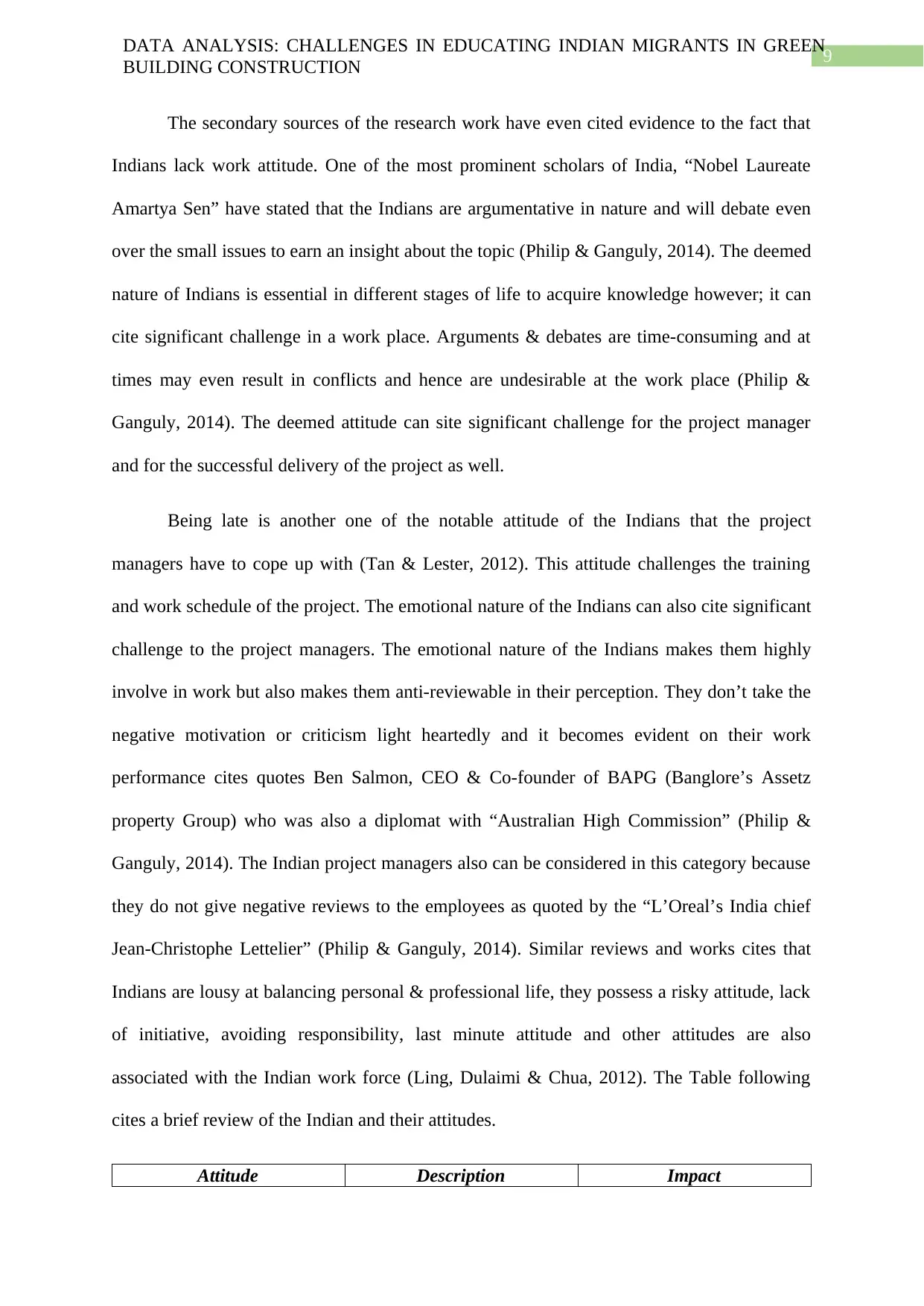
9
DATA ANALYSIS: CHALLENGES IN EDUCATING INDIAN MIGRANTS IN GREEN
BUILDING CONSTRUCTION
The secondary sources of the research work have even cited evidence to the fact that
Indians lack work attitude. One of the most prominent scholars of India, “Nobel Laureate
Amartya Sen” have stated that the Indians are argumentative in nature and will debate even
over the small issues to earn an insight about the topic (Philip & Ganguly, 2014). The deemed
nature of Indians is essential in different stages of life to acquire knowledge however; it can
cite significant challenge in a work place. Arguments & debates are time-consuming and at
times may even result in conflicts and hence are undesirable at the work place (Philip &
Ganguly, 2014). The deemed attitude can site significant challenge for the project manager
and for the successful delivery of the project as well.
Being late is another one of the notable attitude of the Indians that the project
managers have to cope up with (Tan & Lester, 2012). This attitude challenges the training
and work schedule of the project. The emotional nature of the Indians can also cite significant
challenge to the project managers. The emotional nature of the Indians makes them highly
involve in work but also makes them anti-reviewable in their perception. They don’t take the
negative motivation or criticism light heartedly and it becomes evident on their work
performance cites quotes Ben Salmon, CEO & Co-founder of BAPG (Banglore’s Assetz
property Group) who was also a diplomat with “Australian High Commission” (Philip &
Ganguly, 2014). The Indian project managers also can be considered in this category because
they do not give negative reviews to the employees as quoted by the “L’Oreal’s India chief
Jean-Christophe Lettelier” (Philip & Ganguly, 2014). Similar reviews and works cites that
Indians are lousy at balancing personal & professional life, they possess a risky attitude, lack
of initiative, avoiding responsibility, last minute attitude and other attitudes are also
associated with the Indian work force (Ling, Dulaimi & Chua, 2012). The Table following
cites a brief review of the Indian and their attitudes.
Attitude Description Impact
DATA ANALYSIS: CHALLENGES IN EDUCATING INDIAN MIGRANTS IN GREEN
BUILDING CONSTRUCTION
The secondary sources of the research work have even cited evidence to the fact that
Indians lack work attitude. One of the most prominent scholars of India, “Nobel Laureate
Amartya Sen” have stated that the Indians are argumentative in nature and will debate even
over the small issues to earn an insight about the topic (Philip & Ganguly, 2014). The deemed
nature of Indians is essential in different stages of life to acquire knowledge however; it can
cite significant challenge in a work place. Arguments & debates are time-consuming and at
times may even result in conflicts and hence are undesirable at the work place (Philip &
Ganguly, 2014). The deemed attitude can site significant challenge for the project manager
and for the successful delivery of the project as well.
Being late is another one of the notable attitude of the Indians that the project
managers have to cope up with (Tan & Lester, 2012). This attitude challenges the training
and work schedule of the project. The emotional nature of the Indians can also cite significant
challenge to the project managers. The emotional nature of the Indians makes them highly
involve in work but also makes them anti-reviewable in their perception. They don’t take the
negative motivation or criticism light heartedly and it becomes evident on their work
performance cites quotes Ben Salmon, CEO & Co-founder of BAPG (Banglore’s Assetz
property Group) who was also a diplomat with “Australian High Commission” (Philip &
Ganguly, 2014). The Indian project managers also can be considered in this category because
they do not give negative reviews to the employees as quoted by the “L’Oreal’s India chief
Jean-Christophe Lettelier” (Philip & Ganguly, 2014). Similar reviews and works cites that
Indians are lousy at balancing personal & professional life, they possess a risky attitude, lack
of initiative, avoiding responsibility, last minute attitude and other attitudes are also
associated with the Indian work force (Ling, Dulaimi & Chua, 2012). The Table following
cites a brief review of the Indian and their attitudes.
Attitude Description Impact
Paraphrase This Document
Need a fresh take? Get an instant paraphrase of this document with our AI Paraphraser
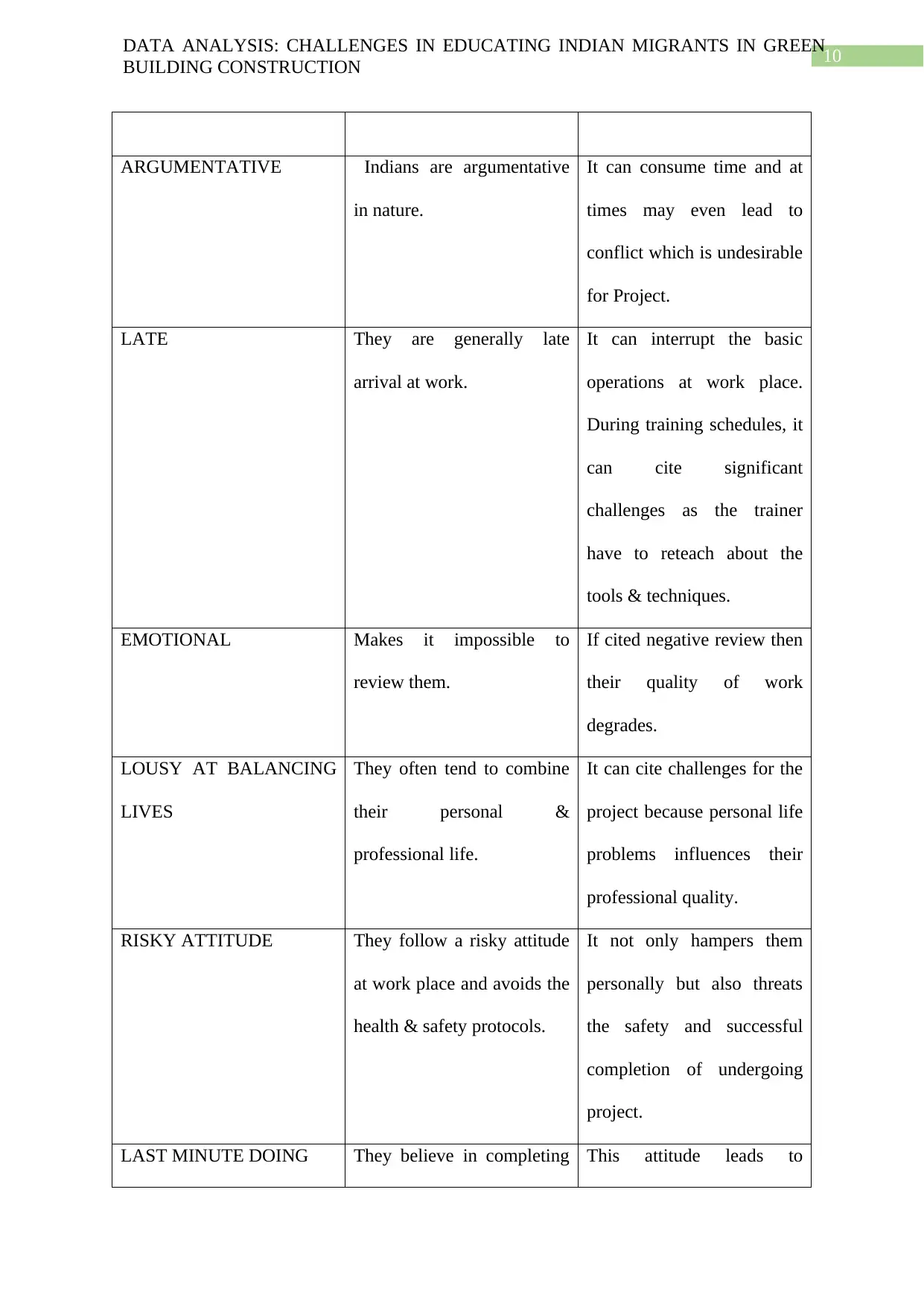
10
DATA ANALYSIS: CHALLENGES IN EDUCATING INDIAN MIGRANTS IN GREEN
BUILDING CONSTRUCTION
ARGUMENTATIVE Indians are argumentative
in nature.
It can consume time and at
times may even lead to
conflict which is undesirable
for Project.
LATE They are generally late
arrival at work.
It can interrupt the basic
operations at work place.
During training schedules, it
can cite significant
challenges as the trainer
have to reteach about the
tools & techniques.
EMOTIONAL Makes it impossible to
review them.
If cited negative review then
their quality of work
degrades.
LOUSY AT BALANCING
LIVES
They often tend to combine
their personal &
professional life.
It can cite challenges for the
project because personal life
problems influences their
professional quality.
RISKY ATTITUDE They follow a risky attitude
at work place and avoids the
health & safety protocols.
It not only hampers them
personally but also threats
the safety and successful
completion of undergoing
project.
LAST MINUTE DOING They believe in completing This attitude leads to
DATA ANALYSIS: CHALLENGES IN EDUCATING INDIAN MIGRANTS IN GREEN
BUILDING CONSTRUCTION
ARGUMENTATIVE Indians are argumentative
in nature.
It can consume time and at
times may even lead to
conflict which is undesirable
for Project.
LATE They are generally late
arrival at work.
It can interrupt the basic
operations at work place.
During training schedules, it
can cite significant
challenges as the trainer
have to reteach about the
tools & techniques.
EMOTIONAL Makes it impossible to
review them.
If cited negative review then
their quality of work
degrades.
LOUSY AT BALANCING
LIVES
They often tend to combine
their personal &
professional life.
It can cite challenges for the
project because personal life
problems influences their
professional quality.
RISKY ATTITUDE They follow a risky attitude
at work place and avoids the
health & safety protocols.
It not only hampers them
personally but also threats
the safety and successful
completion of undergoing
project.
LAST MINUTE DOING They believe in completing This attitude leads to
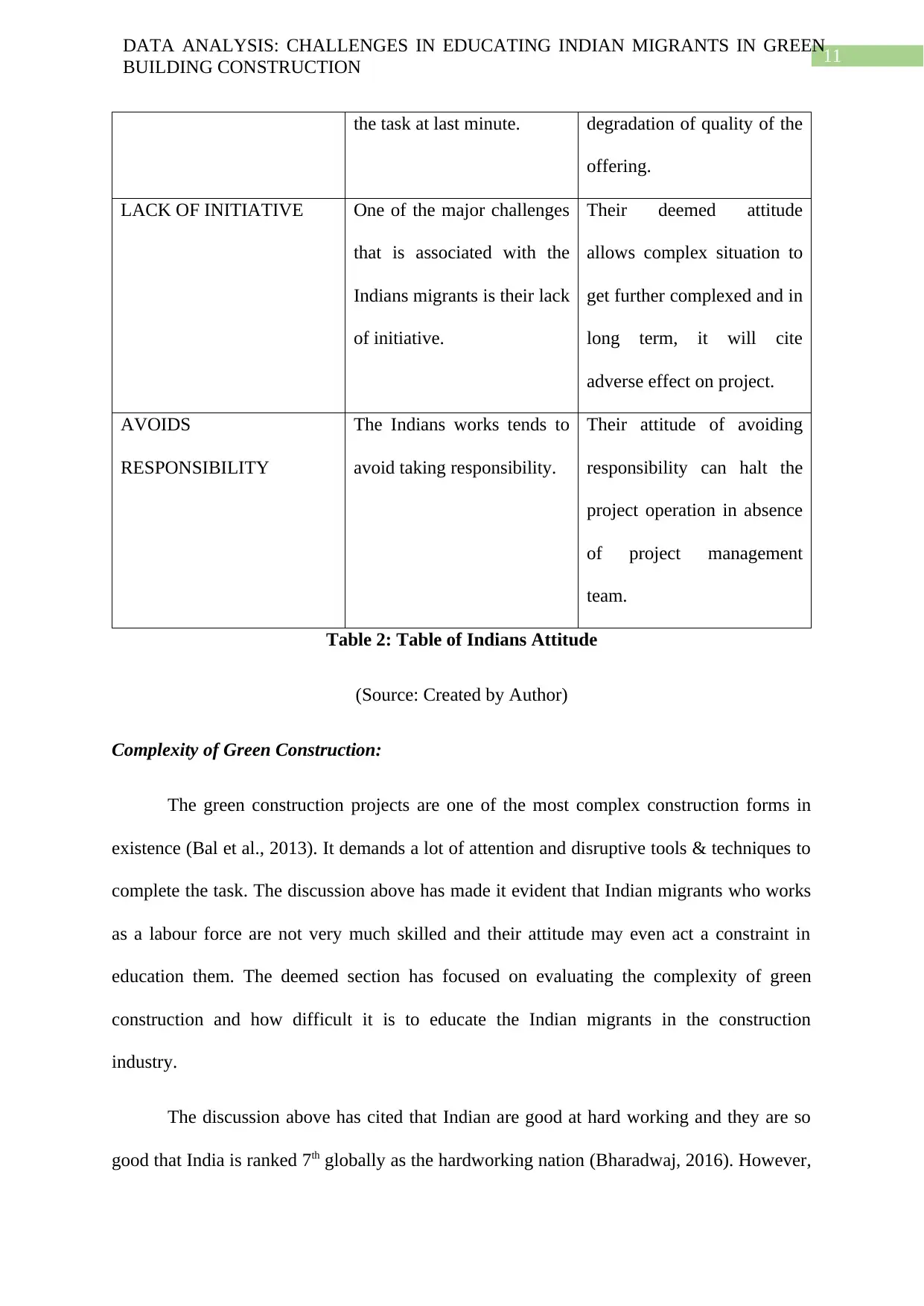
11
DATA ANALYSIS: CHALLENGES IN EDUCATING INDIAN MIGRANTS IN GREEN
BUILDING CONSTRUCTION
the task at last minute. degradation of quality of the
offering.
LACK OF INITIATIVE One of the major challenges
that is associated with the
Indians migrants is their lack
of initiative.
Their deemed attitude
allows complex situation to
get further complexed and in
long term, it will cite
adverse effect on project.
AVOIDS
RESPONSIBILITY
The Indians works tends to
avoid taking responsibility.
Their attitude of avoiding
responsibility can halt the
project operation in absence
of project management
team.
Table 2: Table of Indians Attitude
(Source: Created by Author)
Complexity of Green Construction:
The green construction projects are one of the most complex construction forms in
existence (Bal et al., 2013). It demands a lot of attention and disruptive tools & techniques to
complete the task. The discussion above has made it evident that Indian migrants who works
as a labour force are not very much skilled and their attitude may even act a constraint in
education them. The deemed section has focused on evaluating the complexity of green
construction and how difficult it is to educate the Indian migrants in the construction
industry.
The discussion above has cited that Indian are good at hard working and they are so
good that India is ranked 7th globally as the hardworking nation (Bharadwaj, 2016). However,
DATA ANALYSIS: CHALLENGES IN EDUCATING INDIAN MIGRANTS IN GREEN
BUILDING CONSTRUCTION
the task at last minute. degradation of quality of the
offering.
LACK OF INITIATIVE One of the major challenges
that is associated with the
Indians migrants is their lack
of initiative.
Their deemed attitude
allows complex situation to
get further complexed and in
long term, it will cite
adverse effect on project.
AVOIDS
RESPONSIBILITY
The Indians works tends to
avoid taking responsibility.
Their attitude of avoiding
responsibility can halt the
project operation in absence
of project management
team.
Table 2: Table of Indians Attitude
(Source: Created by Author)
Complexity of Green Construction:
The green construction projects are one of the most complex construction forms in
existence (Bal et al., 2013). It demands a lot of attention and disruptive tools & techniques to
complete the task. The discussion above has made it evident that Indian migrants who works
as a labour force are not very much skilled and their attitude may even act a constraint in
education them. The deemed section has focused on evaluating the complexity of green
construction and how difficult it is to educate the Indian migrants in the construction
industry.
The discussion above has cited that Indian are good at hard working and they are so
good that India is ranked 7th globally as the hardworking nation (Bharadwaj, 2016). However,
⊘ This is a preview!⊘
Do you want full access?
Subscribe today to unlock all pages.

Trusted by 1+ million students worldwide
1 out of 24
Related Documents
Your All-in-One AI-Powered Toolkit for Academic Success.
+13062052269
info@desklib.com
Available 24*7 on WhatsApp / Email
![[object Object]](/_next/static/media/star-bottom.7253800d.svg)
Unlock your academic potential
Copyright © 2020–2025 A2Z Services. All Rights Reserved. Developed and managed by ZUCOL.





